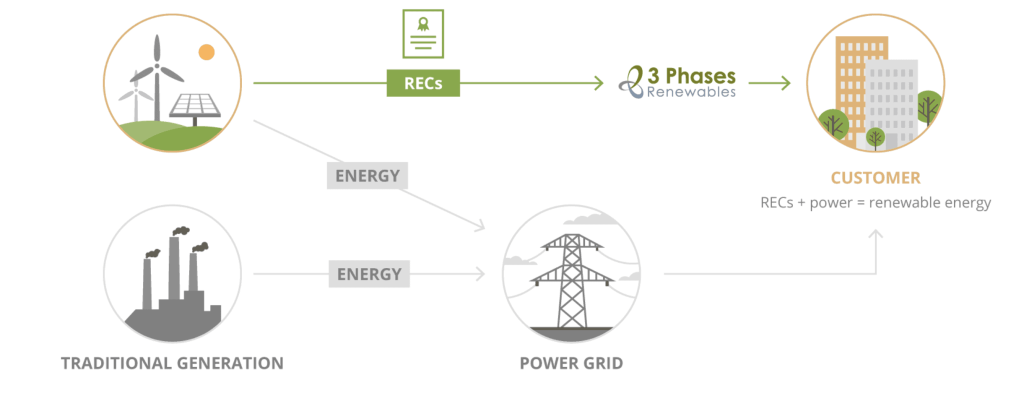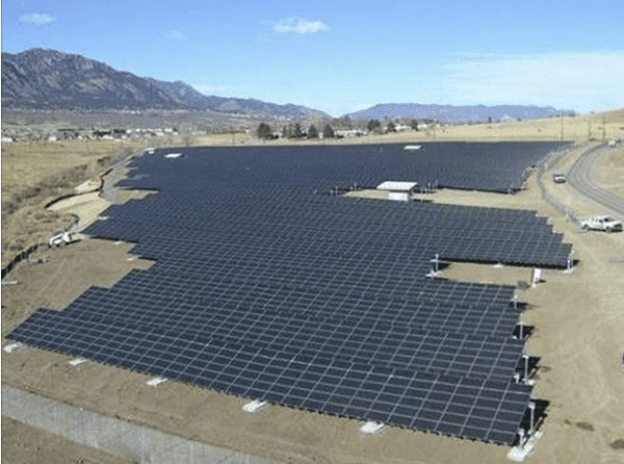The promise of renewable energy sources is that they will improve sustainability—not just for the environment, but for businesses. After all, solar and wind aren’t subject to all the same forces as coal, natural gas, or nuclear fuel sources, and business owners value that kind of stability.
Yet after seeing the turbulence in utility prices in recent times, many commercial energy customers are wondering about the forecast of energy costs in a future with greater shares of renewable energy—and how they can better access those resources.
Eric Hulin, Director of Sales & Marketing at 3 Phases Renewables, explains that companies like his offer a valuable perspective on the direction of renewable energy. “We’re completely focused on selling a high mix of renewable electricity, whereas other larger electricity suppliers focus on selling traditional commodity power,” he says. “The fact that we’ve been doing this for a lot of years is unique.”
Eric sat down with King Energy CEO John Witchel to discuss his work at 3 Phases Renewables, addressing the challenges for customers wanting to source renewable electricity directly and discussing how his business offers valuable and versatile solutions.
3 Phases Renewables lives at the center of renewable electricity
3 Phases Renewables was founded two decades ago, with a focus on providing 100% renewable energy to customers at a time when there was full deregulation in the California energy markets.
Since then, customers’ demand for renewable energy has increased, as they want both lower cost energy and greater sustainability. Fortunately, renewables are increasingly available in the market, especially thanks to companies like 3 Phases. However, implementing renewable electricity is not as simple as switching your energy source with the utility: electricity supplies are blended together to feed the grid.
“I always joke that when our renewables customers turn the light on, it turns on the same color—it doesn’t shine green,” Eric says. “You can’t always tell where the electricity is coming from.”
“When our renewables customers turn the light on, it turns on the same color—it doesn’t shine green.”
In reality, real-time energy supply through traditional utilities is dynamic. If, within a given pool for a given time, all the load can be served by solar, then it will (and the electricity will be much cheaper in real time). When the load increases, it sources electricity from additional inputs, blending them all together—and essentially blending the costs, as well.
In other words, many electricity customers cannot yet convert entirely to renewable energy through the utility. The electricity they access is largely out of their control. But, Eric sees other ways for them to effectively source green energy.
Alternative means of sourcing renewable electricity
“There’s a number of different ways that (these) customers can procure renewable electricity from an electricity supplier,” Eric says. These include:
- Direct access from a clean energy supplier, such as 3 Phases Renewables
- Onsite solar (coupled with storage)
- Renewable energy credits, or RECs
“Direct Access is a program where commercial, industrial, and municipal customers can procure electricity from an entity other than the standard or traditional utility,” Eric explains. In California, the Direct Access customer purchases electricity from an alternative Electric Service Provider, although that power is still delivered by the utility via its established distribution system. “That still is the main part of our business.”
RECs, which get generated alongside every megawatt hour of renewable energy, make renewable energy trackable and attainable for customers. “People don’t talk about RECs as much because they’re less exciting than putting solar panels on the roof,” Eric says. “But it’s a common way for a lot of businesses to procure renewables.”
In short: a business that purchases a REC is claiming the ownership of 1 MWh (1000 kWh) of generated renewable energy, even if those specific electrons are not necessarily traveling directly to the business.
Understanding how RECs provide renewable energy is more abstract than visualizing physical solar panels attached to the roof—after all, you can’t trace where exactly an electron goes, unless the wire goes straight from the panel to the outlet. But you can track a REC, which was originally brought about to enable ownership of renewable electricity. “Various tracking systems, across the US and other parts of the world, make sure that the REC is not double-counted, ensuring the renewable electricity claim,” Eric says.
The continuing value of RECs
Upon their implementation, RECs were certainly a useful tool to jumpstart the renewables industry. Eric identifies their still-ongoing worth in the market.
“I don’t see us ever coming to a point where everybody has panels on the roof and storage in the garage,” he says. “So the concept of a REC, and the value of tracking the ownership of renewable electricity, will continue to have value over time.”
“The concept of a REC, and the value of tracking the ownership of renewable electricity, will continue to have value over time.”
RECs are still proving useful to incentivize the placement of renewable energy in markets like the Northeast US. Companies that generate renewable electricity can sell RECs for significant value, positioning them as an important component of making a renewable system work financially.

When renewable energy is generated, two monetized components are created – the first component is the electricity and the second component is the RECs (for every 1 MWh [1000 kWh] of electricity generated, a REC is produced).
Furthermore, RECs are also used as compliance mechanisms for energy companies. In California, which has established a goal of 60% renewable energy by 2030 (nearly doubling 2020 levels), the Public Utilities Commission tracks the renewable percentage of energy suppliers and load-serving entities with RECs.
“We are already in a place where RECs are reviewed on a regulatory level,” Eric says. “And if folks aren’t meeting their requirements, then there are penalties.”
Increase in renewables forecasts moderation in costs
Of course, an increase in renewable energy matters to customers and governments alike for sustainability reasons. Yet, amidst ever-increasing commercial energy costs, particularly in locations like California, Eric forecasts other reasons to be excited about the future of renewables.
Because electricity is created from a blend of standard and sustainable sources, the price fluctuates depending on the mix. One of the big factors on price is how much renewable energy is included in that blend.
Traditional energy inputs, such as coal or nuclear power plants, require energy sources that cost money. With renewables such as solar and wind, there are no long-term input costs to keep prices steady or increasing over time. There are upfront charges for the materials, manufacturing, and labor to install and maintain the system, but the lack of ongoing fuel costs drives down the price of the resulting electricity.
Final thoughts: Hope for the near future of electricity
Eric acknowledges that 2022 was a rough year for energy costs, and that even the cost of renewables increased due to inflation. Such variance is likely to continue in the near-term, he says, because of economic issues like inflation as well as technical issues—namely, the cost, availability, and limitations of energy storage.
Short-term, Eric predicts a fair amount of price volatility and more price increases. “For the next three to five years, we’ve still got a lot of growing pains to go through as we transition to a grid with more renewable energy,” he says.
Eric believes we will see a reduction in the shorter-term issues, in particular with getting more storage on the grid. While distribution costs—think infrastructure—will continue to rise, with costs being passed-on to energy customers, renewables will serve as a counterweight to tamper price increases.
“Longer-term,” Eric says, “with the fact that renewable energy prices are stable and going down, they’re going to help stabilize prices on the electricity side.”
 3 Phase Energy has several active solar projects including this project: FORT CARSON ARMY BASE, Colorado Springs, CO.
3 Phase Energy has several active solar projects including this project: FORT CARSON ARMY BASE, Colorado Springs, CO.
